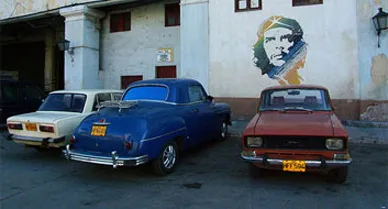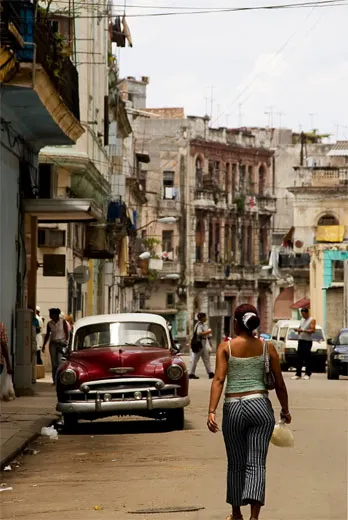Before the Revolution
Socialites and celebrities flocked to Cuba in the 1950s
/https://tf-cmsv2-smithsonianmag-media.s3.amazonaws.com/filer/cuba_walking.jpg)
Americans can't travel to Cuba, but tourists from other parts of the world—mostly Europe and Canada—visit the island for its beaches, culture, Spanish colonial architecture and vintage American cars. They buy art and Che Guevara souvenirs in outdoor markets and drink beer in newly restored plazas, where musicians play Buena Vista Social Club tunes in a constant loop.
In some places, the country appears stuck in its pre-revolutionary past. The famous Hotel Nacional displays photographs of mobsters and celebrity guests. La Tropicana still features a nightly cabaret. And many Hemingway fans stop at La Floridita, one of his favorite haunts, to slurp down overpriced rum cocktails.
For many tourists, 1950s Cuba holds romantic appeal. Last year, more than two million people visited the island, bringing in revenues of $2.4 billion, according to the Cuban government. The tourism industry has saved Cuba from economic ruin more than once—most recently after the Soviet Union collapsed in the early 1990s. But tourism has provoked a tension between the sultry image paradise travelers expect to find and the country's steadfast desire to remain independent. In the years leading up to the Socialist Revolution, the façade came crashing down.
Cuba's reputation as an exotic and permissive playground came to light in the 1920s, when the country became a favorite destination for robber barons and bohemians. Scions like the Whitneys and the Biltmores, along with luminaries such as New York City Mayor Jimmy "Beau James" Walker, flocked to Cuba for winter bouts of gambling, horse racing, golfing and country-clubbing.
Sugar was Cuba's economic lifeline, but its tropical beauty—and tropical beauties—made American tourism a natural and flowing source of revenue. A 1956 issue of Cabaret Quarterly, a now-defunct tourism magazine, describes Havana as "a mistress of pleasure, the lush and opulent goddess of delights."
By the 1950s Cuba was playing host to celebrities like Ava Gardner, Frank Sinatra and Ernest Hemingway. But the advent of cheap flights and hotel deals made the once-exclusive hotspot accessible to American masses. For around $50—a few hundred dollars today—tourists could purchase round-trip tickets from Miami, including hotel, food and entertainment. Big-name acts, beach resorts, bordellos and buffets were all within reach.
"Havana was then what Las Vegas has become," says Louis Perez, a Cuba historian at the University of North Carolina at Chapel Hill. It attracted some of the same mafia kingpins, too, such as Meyer Lansky and Santo Trafficante, who were evading a national investigation into organized crime. In Cuba, they could continue their stock trade of gambling, drugs and prostitution, as long as they paid off government officials. The fees, however high, were a small price for an industry that raked in millions of dollars every month.
But while tourists eagerly spun the roulette wheel in sexy Havana, a revolution brewed in the less glamorous countryside. The sugar boom that had fueled much of Cuba's economic life was waning, and by the mid-'50s it was clear that expectations had exceeded results. With no reliable economic replacement in sight, Cubans began to feel the squeeze. Poverty, particularly in the provinces, increased.
Unlike other Caribbean islands, however, Cuba boasted a large upper-middle class. Cubans had fought vehemently for independence from Spain from the 1860s to the 1890s, but by the 20th century, the country had become beholden economically to the United States.
By the late '50s, U.S. financial interests included 90 percent of Cuban mines, 80 percent of its public utilities, 50 percent of its railways, 40 percent of its sugar production and 25 percent of its bank deposits—some $1 billion in total. American influence extended into the cultural realm, as well. Cubans grew accustomed to the luxuries of American life. They drove American cars, owned TVs, watched Hollywood movies and shopped at Woolworth's department store. The youth listened to rock and roll, learned English in school, adopted American baseball and sported American fashions.
In return, Cuba got hedonistic tourists, organized crime and General Fulgencio Batista. In military power since the early 1930s, Batista appointed himself president by way of a military coup in 1952, dashing Cubans' long-held hope for democracy.
Not only was the economy weakening as a result of U.S. influence, but Cubans were also offended by what their country was becoming: a haven for prostitution, brothels and gambling.
"Daily life had developed into a relentless degradation," writes Louis Perez in his 1999 book On Becoming Cuban, "with the complicity of political leaders and public officials who operated at the behest of American interests."
In 1957, a group of students fed up with government corruption stormed the National Palace. Many historians consider this a turning point in the revolution.
Over the next few years, bursts of violence erupted throughout the city. Bombs exploded in movie theaters and nightclubs. Gunshots rang out. Dead bodies turned up on sidewalks and streets.
"There had been an idealization of the [Cuba's] War of Independence and of being a revolutionary," says Uva de Aragon, a Cuban academic now living in Miami. "In this climate, people thought revolution was a solution to problems."
Bloody battles ensued between Batista's troops and the rebels in the mountains. Still, Cubans tried to keep some normalcy in their lives, going to school, watching baseball games and taking cha-cha lessons.
"It was surreal," says de Aragon. "There was a lot of fear in those last two or three years." A teenager at the time, she was particularly aware of what was happening because her step-father, Carlos Marquez Sterling, had run for president against Batista and lost; Marquez wanted negotiation, but Batista's camp claimed power.
All classes of Cubans, including the very rich, looked to the young and charismatic Fidel Castro as their hope for democracy and change. Castro, a young lawyer trained at the University of Havana, belonged to a wealthy landowning family, but espoused a deep nationalism and railed against corruption and gambling. "We all thought this was the Messiah," says Maria Christina Halley, one of Uva's childhood friends. Her family later fled to the United States and now she teaches Spanish in Jacksonville, Florida.
When Castro's entourage finally arrived in Havana in January of 1959 after defeating Batista's troops, Batista had already fled in the middle of the night, taking more than $40 million of government funds.
In protest of the government's corruption, Cubans immediately ransacked the casinos and destroyed the parking meters that Batista had installed. Castro also eliminated gambling and prostitution, a healthy move for the national identity, but not so much for the tourism industry.
More than 350,000 visitors came to Cuba in 1957; by 1961, the number of American tourists had dropped to around 4,000. The U.S. government, responding to increasing intolerance of Castro's communism, delivered a final blow by enacting the trade and travel embargo in 1963, still in place today, closing off the popular Caribbean playground to Americans.
Still, the excitement and solidarity brought by the new government didn't last long, Halley says. Many of Castro's supporters ended up fleeing when they realized his Communist intentions. Between 1959 and 1970, half a million Cubans left the country.
"It all happened so fast," says Halley, who boarded a plane with just one suitcase in 1960, expecting to come back in a few months. Almost 50 years later, she and many others who left are still waiting for a chance to return.
Natasha Del Toro, a journalist in Tampa Bay, Florida, has produced a short documentary for PBS Frontline World on Cuban artists.
/https://tf-cmsv2-smithsonianmag-media.s3.amazonaws.com/accounts/headshot/natasha-geiling-240.jpg)


/https://tf-cmsv2-smithsonianmag-media.s3.amazonaws.com/accounts/headshot/natasha-geiling-240.jpg)